Monday, May 31st 2021

AMD Announces Ryzen 5000G and PRO 5000G Desktop Processors
AMD today announced the launch of its first Ryzen 5000 series desktop processors with integrated graphics, under the Ryzen 5000G and Ryzen Pro 5000G lines. These processors are based on the 7 nm "Cezanne" silicon, featuring up to 8 CPU cores based on the "Zen 3" microarchitecture, an iGPU based on the "Vega" graphics architecture with up to 8 compute units, but updated display- and media-acceleration engines; 512 KB of L2 cache per core, and 16 MB of L3 cache that's shared between all eight cores. Built in the Socket AM4 package, the processors are compatible with AMD 500-series chipset motherboards. The chips feature PCI-Express Gen 3 downstream I/O.
The consumer Ryzen 5000G series include the Ryzen 7 5700G, and the Ryzen 5 5600G. The 5700G features an 8-core/16-thread CPU, clock speeds of 3.80 GHz, with up to 4.60 GHz boost, and all 8 iGPU compute units being unlocked with up to 2.00 GHz engine clocks. The 5600G, on the other hand, has a 6-core/12-thread CPU clocked at 3.90 GHz, with up to 4.40 GHz boost, and 7 iGPU compute units with up to 1.90 GHz engine clocks. Both chips have their TDP rated at 65 W. AMD claims that the 5700G beats the Core i7-11700 in a variety of content creation and iGPU gaming tasks, as shown in the graphs below; and the iGPU is capable of 1080p e-sports gaming. The 5700G is priced at USD $359, and the 5600G goes for $259. Both chips are available from August 5, 2021.Moving on to the commercial desktop processor segment, and AMD launched three Ryzen Pro 5000G series processors. These chips are nearly identical to the consumer 5000G, but with two categories based on TDP—the 65 W Pro 5000G series, and the 35 W Pro 5000GE series. The chips feature additional security features, including AMD Shadow Stack technology, Secured-core PC, and FIPS 140-3 certification. The chips also feature AMD Pro management features, a set of features similar to Intel vPro.Among the Pro 5000G series are the 8-core/16-thread Pro 5750G; the 6-core/12-thread Pro 5650G, and the 4-core/8-thread Pro 5350G, with their 35-Watt counterparts, the 5750GE, 5650GE, and 5350GE, respectively. The Pro 5750G is clocked at 3.80 GHz with up to 4.60 GHz boost, while the 5650G does 3.90 GHz with up to 4.40 GHz boost, and the 5350G does 4.00 GHz, with up to 4.20 GHz boost. The "GE" SKUs on average lower the nominal clock speeds by 400-800 MHz, and feature aggressive power management to achieve the power target. The company didn't release pricing for the Pro SKUs as they're sold exclusively in the commercial desktop segment, via OEMs.The AMD Ryzen PRO 5000G desktop processor slide-deck follows.
The consumer Ryzen 5000G series include the Ryzen 7 5700G, and the Ryzen 5 5600G. The 5700G features an 8-core/16-thread CPU, clock speeds of 3.80 GHz, with up to 4.60 GHz boost, and all 8 iGPU compute units being unlocked with up to 2.00 GHz engine clocks. The 5600G, on the other hand, has a 6-core/12-thread CPU clocked at 3.90 GHz, with up to 4.40 GHz boost, and 7 iGPU compute units with up to 1.90 GHz engine clocks. Both chips have their TDP rated at 65 W. AMD claims that the 5700G beats the Core i7-11700 in a variety of content creation and iGPU gaming tasks, as shown in the graphs below; and the iGPU is capable of 1080p e-sports gaming. The 5700G is priced at USD $359, and the 5600G goes for $259. Both chips are available from August 5, 2021.Moving on to the commercial desktop processor segment, and AMD launched three Ryzen Pro 5000G series processors. These chips are nearly identical to the consumer 5000G, but with two categories based on TDP—the 65 W Pro 5000G series, and the 35 W Pro 5000GE series. The chips feature additional security features, including AMD Shadow Stack technology, Secured-core PC, and FIPS 140-3 certification. The chips also feature AMD Pro management features, a set of features similar to Intel vPro.Among the Pro 5000G series are the 8-core/16-thread Pro 5750G; the 6-core/12-thread Pro 5650G, and the 4-core/8-thread Pro 5350G, with their 35-Watt counterparts, the 5750GE, 5650GE, and 5350GE, respectively. The Pro 5750G is clocked at 3.80 GHz with up to 4.60 GHz boost, while the 5650G does 3.90 GHz with up to 4.40 GHz boost, and the 5350G does 4.00 GHz, with up to 4.20 GHz boost. The "GE" SKUs on average lower the nominal clock speeds by 400-800 MHz, and feature aggressive power management to achieve the power target. The company didn't release pricing for the Pro SKUs as they're sold exclusively in the commercial desktop segment, via OEMs.The AMD Ryzen PRO 5000G desktop processor slide-deck follows.


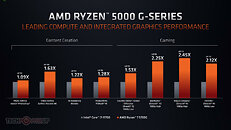
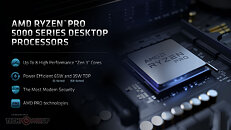
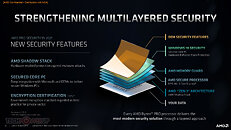
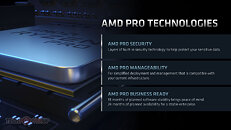



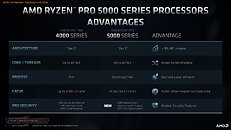
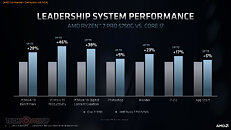
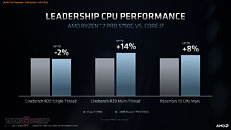


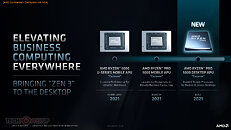
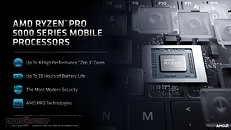

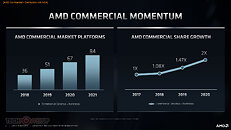


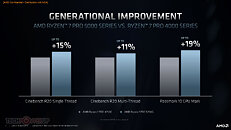

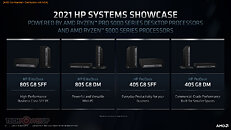
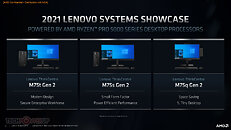




37 Comments on AMD Announces Ryzen 5000G and PRO 5000G Desktop Processors
holy shit. These are gunna make some monster laptops/All in one systems
Like I said it mostly depends on clocks, the best mobile processor is about ~20% faster than the previous gen leader in 4900h.
Before anybody asks why bother, I know very well what a 65 W TDP means in AMD's terms - much higher actual power consumption, combine that with the heat density of 7 nm chips, and you get a solution that's impossible to cool with a low-profile cooler. Been there, done that, no thanks.
My current motherboard - APU combo allows me to lower the APU TDP in BIOS; it lets me choose between 65W, 35W and custom TDP profiles. I imagine that would be perfect in your case, and performance is still plenty good with a lower TDP as those U chips show.
edit
www.amd.com/en/products/cpu/amd-ryzen-7-5800
well guess I will skip out this gen...........don't want or need the 'x' version.......................hmmm that 5700G though, same clocks as the 5800X, but half the L3 cache and pcie v3.0, but $100 cheaper.....hmmmmmm
The 4000-series was fantastic, though I guess they simply didn't want to gamble on retail availability for such a small product segment with limited chip supplies (I remember there were reports of low supplies of 4000-series laptop APUs for half a year after launch). Of course now there's a global chip shortage, but given the success of Ryzen 5000 in mobile and OEM desktop I think production volumes of the APUs are much higher than last time around - and thus there are likely more chips that fall into the "not that good at 15-45W, but great at 65W" bin. Which is great for us! And while I did want the best possible integrated graphics for my HTPC, I completely understand not wanting a dGPU. Unless you're gaming a lot there simply isn't a point.
Unfortunately, we don't have a 3700x for direct 65w comparison this time!; this105 vs 65 is the only complete review:
I would hold judgement until someone runs 5600g vs 5600x
Though I might add, 65 W on an AMD product means means as much as all the +es on 14 nm+++ Intel CPUs. We only know if it's a direct comparison or not when it comes out and somebody tests it for power consumption and heat.